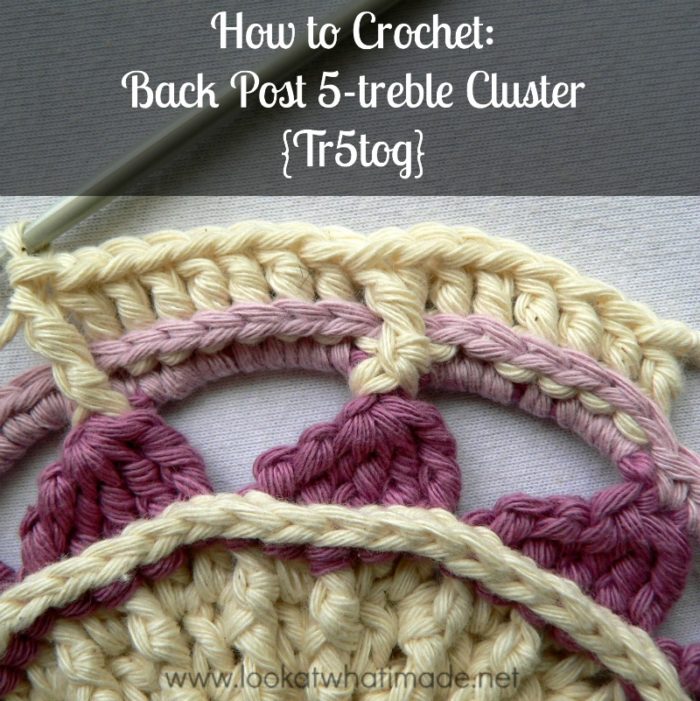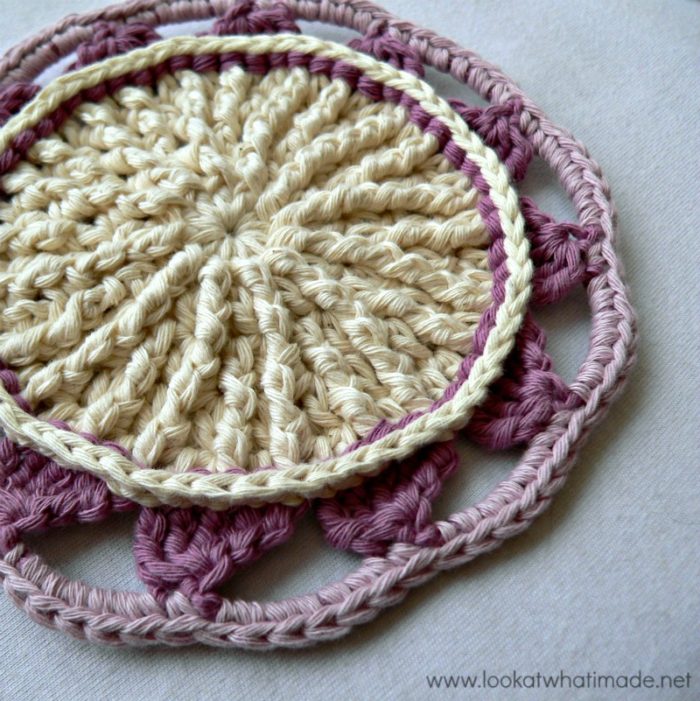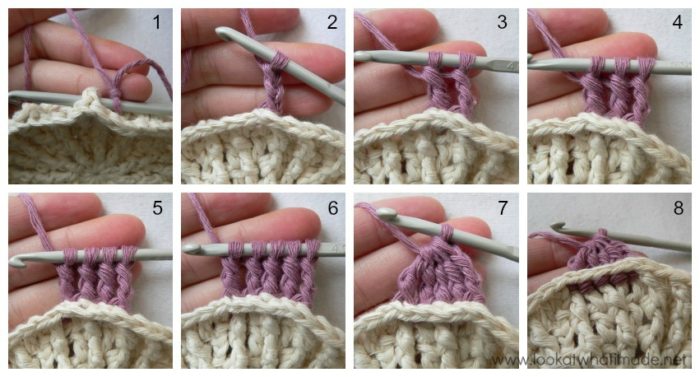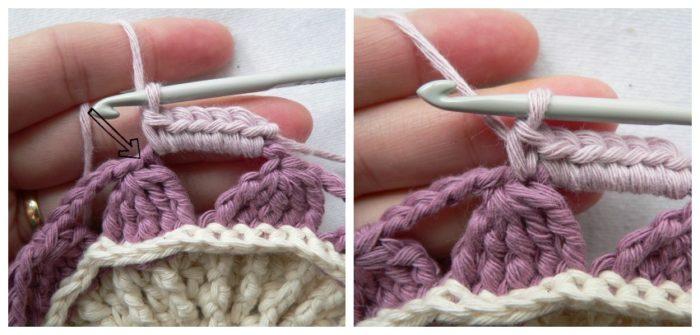The tr5tog, or 5-treble cluster, is not a stitch you will come across often, but when you do, won’t it be handy if you knew how to make it? In this tutorial I will be showing you how to make the 5-treble cluster around the back posts of stitches, but you can just as easily use these instructions to make them into the tops of the stitches as normal. In other words, into the top 2 loops of each st.
This stitch is made by partially completing 5 trebles and then completing them all on the last yarn-over.
The 5-treble cluster is perfect for making triangular petals.
5-treble Cluster {Tr5tog}
Written Instructions
Beginning 5-tr cluster
These instructions are for making the first 5-tr cluster of a row/round.
Ch 3 (counts as first partial tr). *Yarn over twice and insert hook around the post of the next stitch (from back to front). Yarn over and pull up a loop. (Yarn over and pull through 2 loops) twice. There should now be one loop of this treble left on your hook.* Repeat from * to * 3 more times. There should now be 5 loops on your hook. Yarn over and pull through all 5 loops.
Subsequent 5-tr clusters
These instructions are for making 5-tr clusters in the middle of a row/round.
*Yarn over twice and insert hook around the post of the next stitch (from back to front). Yarn over and pull up a loop. (Yarn over and pull through 2 loops) twice. There should now be one loop of this treble left on your hook.* Repeat from * to * 4 more times. There should now be 6 loops on your hook. Yarn over and pull through all 6 loops.
Photo Tutorial
Beginning 5-tr cluster
These instructions are for making the first 5-tr cluster of a row/round.
For the purpose of this tutorial I am using a new colour to better illustrate the process. I will therefore have to join my new yarn with a sl st before I can start. Because I will be making the 5-treble clusters around the back post, I will make my initial sl st around the back post of the relevant stitch by inserting it from back to front around the post of the relevant stitch (Photo 1).
We will now make 5 partial trebles before completing them all on the last yarn-over.
- Ch 3 (counts as first partial tr – see Photo 2).
- Yarn over twice and insert hook around the post of the next stitch (from back to front). Yarn over and pull up a loop (4 loops on your hook). (Yarn over and pull through 2 loops) twice. There should now be 2 loops on your hook (Photo 3).
- Yarn over twice and insert hook around the post of the next stitch (from back to front). Yarn over and pull up a loop (5 loops on your hook). (Yarn over and pull through 2 loops) twice. There should now be 3 loops on your hook (Photo 4).
- Yarn over twice and insert hook around the post of the next stitch (from back to front). Yarn over and pull up a loop (6 loops on your hook). (Yarn over and pull through 2 loops) twice. There should now be 4 loops on your hook (Photo 5).
- Yarn over twice and insert hook around the post of the next stitch (from back to front). Yarn over and pull up a loop (7 loops on your hook). (Yarn over and pull through 2 loops) twice. There should now be 5 loops on your hook (Photo 6).
- Yarn over and pull through all 5 loops (Photo 7).
To check that you haven’t accidentally skipped a stitch, fold your petal back so that you can see the bottom of the stitches. They should form a running stitch (a dotted line) across the front of the posts from the previous round (Photo 8).
Subsequent 5-tr clusters
These instructions are for making 5-tr clusters in the middle of a row/round. They are essentially the same as for the first 5-treble cluster, but you will start off with a partial treble instead of a ch-3 for the first st.
Yarn over twice and insert hook around the post of the next stitch (from back to front). Yarn over and pull up a loop. (Yarn over and pull through 2 loops) twice. There should now be 2 loops on your hook (Photo 1).
Repeat steps 2 – 6 above (see Beginning 5-tr cluster). Please note that you will have one extra loop on your hook at the end of each step. When you have completed all 5 partial trebles, you should have 6 loops on your hook, not 5 (see Photo 2 below).
Yarn over and pull through all 6 loops (Photo 3).
Anatomy of the 5-treble Cluster
Whether working in rows or rounds, you will need to make chain stitches between each 5-treble cluster to make up for the fact that you have turned 5 stitches into 1. When working in straight rows or rounds (like when making a bag worked in the round), you will usually chain 4 between clusters to compensate.
When working in rounds where you need to increase (like when making an afghan square or rug), you will chain 5 or 6, depending on what the pattern calls for.
In the next row/round you might be instructed to work into the top of the cluster stitch. I am going to take a quick look at what the cluster stitch looks like and where the actual top of the stitch is.
As you can see, the 5-treble cluster is triangular. It is made across 5 stitches. You will find the top of the cluster stitch at the top of the cluster and just to the right of it (left if you are left-handed) – see the arrow in the photo to the left below. The photo to the right shows a single crochet made into the top of the cluster.
I hope you find this tutorial useful. If you have any suggestions on how I can make it better, please feel free to contact me.
Related Tutorials

This blog post contains affiliate links. I only link to products I personally use or would use. All opinions are my own.








Angie says
Thank You so much for posting this…Ive been trying to do this stitch forever…I so happy for your help…
Your New Crochet Fan,
Angie
Jenny says
So glad you are finding Dedri’s tutorials to be beneficial. She has such a wonderful way of explaining everything you need to know in her lessons :)
LaTonia says
I saw something that looks similar to this on a Hispanic Crochet video that I can’t find again. Only, after having 6 loops on the hook you yarn over and pull through two, and repeat that two more times until you finish the stitch. I’m not sure if it’s crochet together or all in one stitch. I am trying to find out what that stitch/method is called so I can find it and learn it. Thanks for any info you might have!